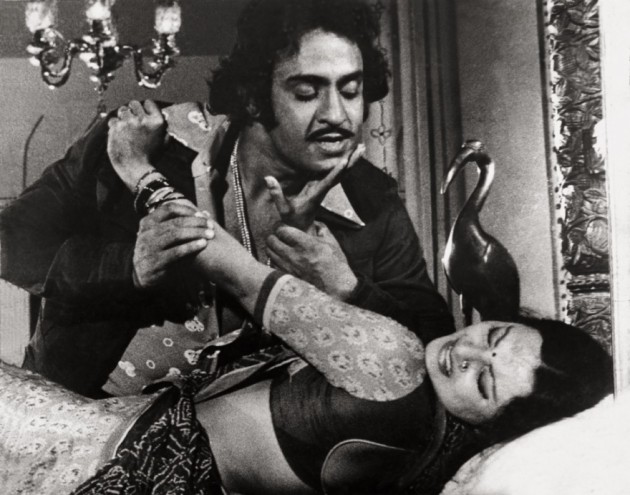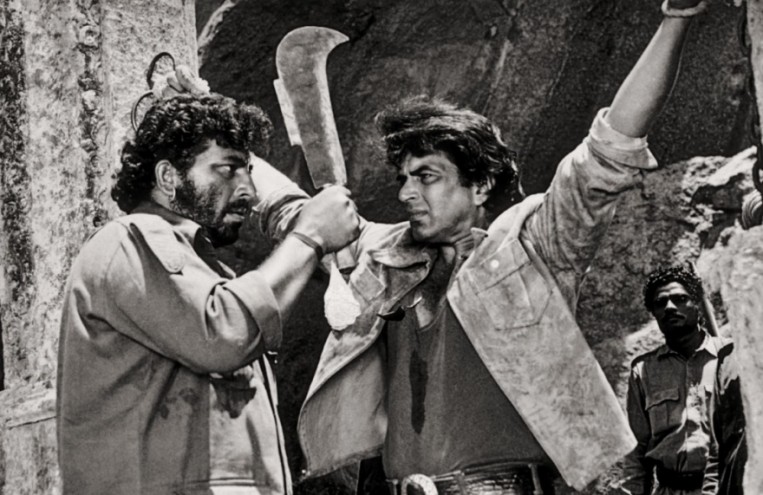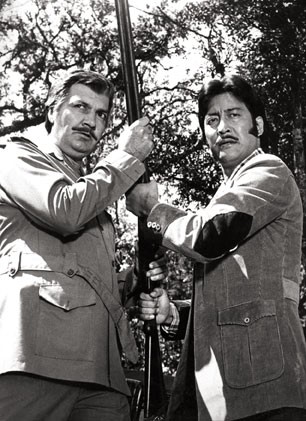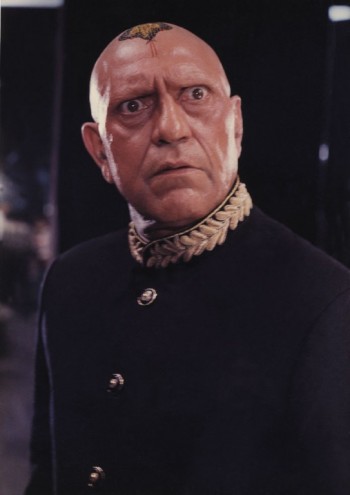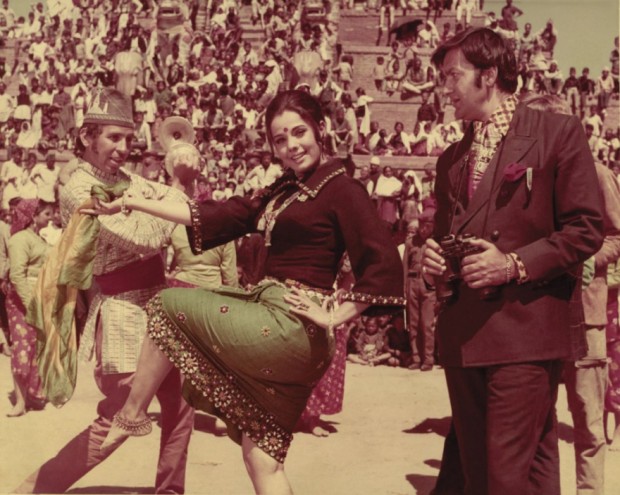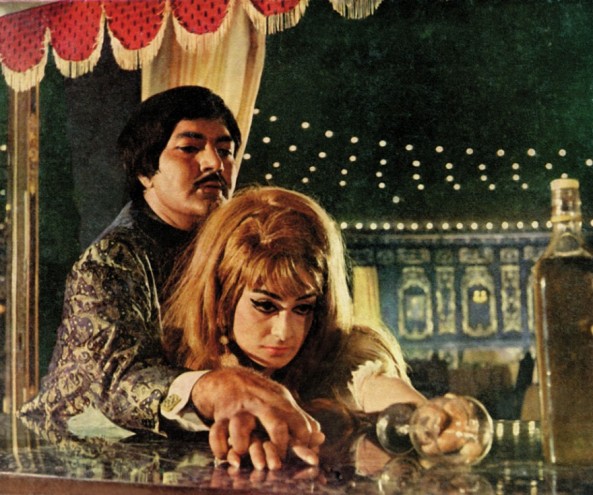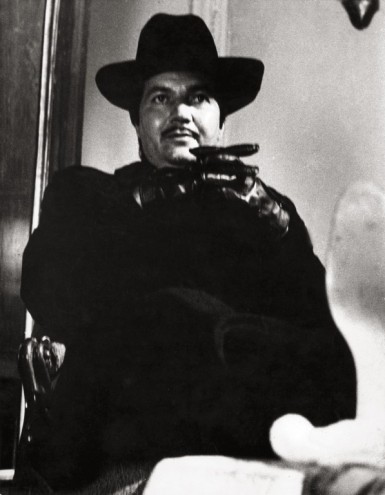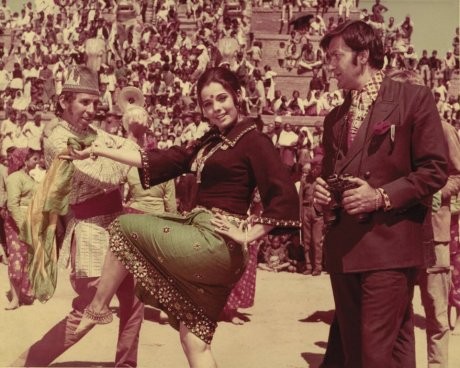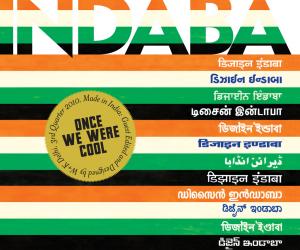First Published in
They left an indelible mark on Bollywood, 30 or even 40 years after they played the roles that made them famous. People still remember their looks, voices, moves and their lines.
They were the ruthless, much feared Bollywood villains. At a time when good characters were plain good and bad ones were truly bad, villains were as important as heroes and heroines. No effort was spared to make the audience hate them, yet the villains have been a much bigger source of inspiration for Indian popular culture than the heroes who were surely nice and good-looking yet somehow terribly uninspiring.
Ranjeet, which was Gopal Bedi’s stage name, was famous for playing the rapist.
While most villains were often portrayed as poor, Ranjeet’s characters were well to do, and this enabled him to be something very unusual. A villain with a great sense of fashion.
An unbuttoned shirt, typically knotted at the bottom and a feminine scarf was his signature outfit, but Ranjeet would wear, with equal charm, perfectly fitted safari suits or elegant jackets with collared shirts and matching ties.
During the 1970s and 1980s there were no stylists in Bollywood, so each actor had the freedom to choose his own clothes or even design tailor-made outfits to express his own unique personality. Ranjeet certainly took advantage of this. It is still surprising that he was allowed to dress in such a stylish way – his characters were not supposed to be charming, but his style certainly dwarfed that of the hero’s.
At the time, no one would have dared imitate Ranjeet’s style in the streets – he was after all, a bad guy – but his looks were such that if it weren’t for his habit of raping beautiful women on the silver screen, he would have definitely been upheld as a fashion icon.
Another actor known for playing the villain, Amjad Khan, will forever be remembered for the character that made him famous: Gabbar Singh.
Gabbar Singh was a dacoit (bandit) in Sholay (1975), a curry western and the highest grossing Indian film of all time that pulled crowds into cinema halls for five years running. Despite the fact that the movie starred several famous actors, Khan’s character is still the first to come to mind.
Ruthless to the point that he would kill his own men in cold blood, every detail about Gabbar Singh contributed to make him the quintessential villain. As a highwayman, he lived in the mountains, rode a horse and wore rough clothes, heavy boots and a belt of bullets slung over his shoulder. A feeling of terror surrounded his character, and in particular the use of an eerie, unsettling sound effect, which signalled his entrance, would give audiences the shivers.
The way he walked and moved, his aggressive voice and his overall appearance – there was nothing redeemable about Gabbar Singh, his meanness was the very essence of his charisma.
Another actor who excelled at being the villain to the point that it earned him fame not just in Bollywood but also in Hollywood, was Amrish Puri.
Puri was chosen by no less than Steven Spielberg to play Mola Ram, the bloodthirsty Thuggee cult leader in Indiana Jones and the Temple of Doom (1984). Who can forget his “Kali ma” incantation as he goes to rip the heart out of a terrified victim?
With his powerful stage presence and booming voice, Puri played several villains, but perhaps his most unforgettable performance was in Mr India (1987), where he was Mogambo, an insane general on the hunt for the formula that would make him invisible and thus, ruler of the world.
His look in the film was exaggerated and he wore a heavily embroidered coat with big epaulettes and fringing, pants tucked into his boots, chunky, heavy rings, a walking stick and what looked like the gelled, blond wig of a 1920s flapper. Mogambo’s image was halfway between Michael Jackson in his Thriller days and a futuristic bandmaster.
No actor, especially one who had already gained his success, would dare going for such an over dramatised look and Puri’s performance in the movie is outstanding. His line “Mogambo khush hua” (Mogambo is pleased) is one of Bolly-wood’s most famous, and can be found written on all sorts of kitsch products.
Another actor who was typecast as the villain, albeit somewhat farcically, especially when compared to his malevolent counterparts, is Prem Chopra. Whenever mentioned, his name immediately triggers the notorious self-introduction of his character in Bobby (1973): “Prem naam hai mera” (My name is Prem).
In a way, Chopra’s characters were similar to those of Ranjeet’s – his were wealthy and consistently kitted out in suits, shirts and scarves, but while Ranjeet looked attractive, Chopra’s look was borderline ridiculous.
Be it the colours he wore, the many wigs, or the choice of accessories – hats, berets, bow ties, big sunglasses – Chopra was unique, if not a little funny looking. The idiosyncratic facial expressions that he pulled only reinforced this look.
Although it didn’t look like it, careful planning went into Chopra’s style. While his villains wore original clothing and accessories, they failed to look fashionable and they would come across as odd and almost irritating.
The Bollywood villains of yesteryear were known for their looks, presence and personalities. Their strength was in their individuality, in the capacity that the actors had to be unique and create their own style and image.
Actors today follow the advice of stylists and have fewer opportunities to inject their own flair. As characters have become more layered, there is next to no place for the role of the old-school villain.
The era of such villains might have passed, but the stylish Ranjeet, the rough Gabbar Singh, the manic Mogambo and the cheesy Prem Chopra will always hold a very special place in Indian popular culture. They will be forever hated, and forever loved.
Manish Arora is one of India's leading fashion designers.
They were iconic and unforgettable. They had unique styles and distinctive personalities. They left an indelible mark on Bollywood.
They were iconic and unforgettable. They had unique styles and distinctive personalities. They left an indelible mark on Bollywood, 30 or even 40 years after they played the roles that made them famous. People still remember their looks, voices, moves and their lines.
They were the ruthless, much feared Bollywood villains. At a time when good characters were plain good and bad ones were truly bad, villains were as important as heroes and heroines. No effort was spared to make the audience hate them, yet the villains have been a much bigger source of inspiration for Indian popular culture than the heroes who were surely nice and good-looking yet somehow terribly uninspiring.
Ranjeet, which was Gopal Bedi’s stage name, was famous for playing the rapist.
While most villains were often portrayed as poor, Ranjeet’s characters were well to do, and this enabled him to be something very unusual. A villain with a great sense of fashion.
An unbuttoned shirt, typically knotted at the bottom and a feminine scarf was his signature outfit, but Ranjeet would wear, with equal charm, perfectly fitted safari suits or elegant jackets with collared shirts and matching ties.
During the 1970s and 1980s there were no stylists in Bollywood, so each actor had the freedom to choose his own clothes or even design tailor-made outfits to express his own unique personality. Ranjeet certainly took advantage of this. It is still surprising that he was allowed to dress in such a stylish way – his characters were not supposed to be charming, but his style certainly dwarfed that of the hero’s.
At the time, no one would have dared imitate Ranjeet’s style in the streets – he was after all, a bad guy – but his looks were such that if it weren’t for his habit of raping beautiful women on the silver screen, he would have definitely been upheld as a fashion icon.
Another actor known for playing the villain, Amjad Khan, will forever be remembered for the character that made him famous: Gabbar Singh.
Gabbar Singh was a dacoit (bandit) in Sholay (1975), a curry western and the highest grossing Indian film of all time that pulled crowds into cinema halls for five years running. Despite the fact that the movie starred several famous actors, Khan’s character is still the first to come to mind.
Ruthless to the point that he would kill his own men in cold blood, every detail about Gabbar Singh contributed to make him the quintessential villain. As a highwayman, he lived in the mountains, rode a horse and wore rough clothes, heavy boots and a belt of bullets slung over his shoulder. A feeling of terror surrounded his character, and in particular the use of an eerie, unsettling sound effect, which signalled his entrance, would give audiences the shivers.
The way he walked and moved, his aggressive voice and his overall appearance – there was nothing redeemable about Gabbar Singh, his meanness was the very essence of his charisma.
Another actor who excelled at being the villain to the point that it earned him fame not just in Bollywood but also in Hollywood, was Amrish Puri.
Puri was chosen by no less than Steven Spielberg to play Mola Ram, the bloodthirsty Thuggee cult leader in Indiana Jones and the Temple of Doom (1984). Who can forget his “Kali ma” incantation as he goes to rip the heart out of a terrified victim?
With his powerful stage presence and booming voice, Puri played several villains, but perhaps his most unforgettable performance was in Mr India (1987), where he was Mogambo, an insane general on the hunt for the formula that would make him invisible and thus, ruler of the world.
His look in the film was exaggerated and he wore a heavily embroidered coat with big epaulettes and fringing, pants tucked into his boots, chunky, heavy rings, a walking stick and what looked like the gelled, blond wig of a 1920s flapper. Mogambo’s image was halfway between Michael Jackson in his Thriller days and a futuristic bandmaster.
No actor, especially one who had already gained his success, would dare going for such an over dramatised look and Puri’s performance in the movie is outstanding. His line “Mogambo khush hua” (Mogambo is pleased) is one of Bolly-wood’s most famous, and can be found written on all sorts of kitsch products.
Another actor who was typecast as the villain, albeit somewhat farcically, especially when compared to his malevolent counterparts, is Prem Chopra. Whenever mentioned, his name immediately triggers the notorious self-introduction of his character in Bobby (1973): “Prem naam hai mera” (My name is Prem).
In a way, Chopra’s characters were similar to those of Ranjeet’s – his were wealthy and consistently kitted out in suits, shirts and scarves, but while Ranjeet looked attractive, Chopra’s look was borderline ridiculous.
Be it the colours he wore, the many wigs, or the choice of accessories – hats, berets, bow ties, big sunglasses – Chopra was unique, if not a little funny looking. The idiosyncratic facial expressions that he pulled only reinforced this look.
Although it didn’t look like it, careful planning went into Chopra’s style. While his villains wore original clothing and accessories, they failed to look fashionable and they would come across as odd and almost irritating.
The Bollywood villains of yesteryear were known for their looks, presence and personalities. Their strength was in their individuality, in the capacity that the actors had to be unique and create their own style and image.
Actors today follow the advice of stylists and have fewer opportunities to inject their own flair. As characters have become more layered, there is next to no place for the role of the old-school villain.
The era of such villains might have passed, but the stylish Ranjeet, the rough Gabbar Singh, the manic Mogambo and the cheesy Prem Chopra will always hold a very special place in Indian popular culture. They will be forever hated, and forever loved.
Manish Arora is one of India's leading fashion designers.

